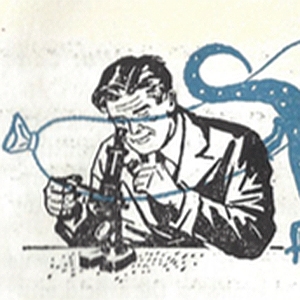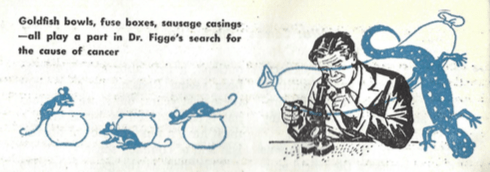
 My grandfather, Frank H.J. Figge, was a cancer researcher who faced shortages during World War II and had to improvise to keep his lab going. When he ran short of quartz lenses he remembered hearing that plastic also transmits ultraviolet rays and filled synthetic sausage casings with water to create a perfect — much cheaper — substitute.
My grandfather, Frank H.J. Figge, was a cancer researcher who faced shortages during World War II and had to improvise to keep his lab going. When he ran short of quartz lenses he remembered hearing that plastic also transmits ultraviolet rays and filled synthetic sausage casings with water to create a perfect — much cheaper — substitute.
Nurses have historically improvised equipment when they had to, using butcher paper to make a bedpan or a rocking chair and roller skates to build a wheelchair. Although nurses’ contributions to innovation have gone unrecognized for years “nursing has a rich tradition of making — one that has produced numerous devices and tools that created a direct path to improved patient outcomes.”
More recently, people living with diabetes have used open source software to link off-the-shelf insulin pumps and continuous glucose monitors to simulate a working pancreas, sharing their designs online so others can benefit.
People are experimenting, creating, and sharing their prototypes, gaining feedback and followers to improve their work and expand the market for it. As the Chief Technology Officer at the U.S. Department of Health and Human Services, I brought entrepreneurs and health hackers into our work in the federal government because I believe that we must build an “innovation nation” that combines our old-fashioned, can-do spirit with newfangled technology.
That’s why I was excited to interview Tiffany Kelley and Anna Young on March 16 at the Lemelson Center.
Tiffany Kelley is a nurse who saw her colleagues writing details about patients on scraps of paper, Post-its, and even paper towels throughout their shifts. The nurses would then verbally relay this vital information at shift changes, introducing an unnecessary risk of forgetting a detail or misreading a scribbled, smudged note. She decided to bridge this communication gap with a nurse-focused app called Know My Patient.
Anna Young helped build the first makerspace in a hospital, at the University of Texas Medical Branch in Galveston, where nurses are given the tools they need to prototype and build solutions to clinical challenges.
For example, Jason Sheaffer is a burn unit nurse who built a portable shower unit with 3 adjustable heads in the hospital’s makerspace. He was inspired by the challenge of treating a victim of a chemical burn, when three nurses worked together for hours, spraying water as best they could, irrigating the skin. It was exhausting and inefficient. Now, with this invention, nurses can direct the nozzles where the water is needed and be free to care for the patient in other ways.
Here’s what I see in the landscape:
- Barriers to entry are being lowered in communications, design capabilities, and manufacturing.
- Collaboration across time and space is now possible.
- Crowdfunding is now possible.
What will happen when everyone has access to the tools and information they need to solve their own problems — and share their ideas with others?
(Learn more about the March 16 event, including background on the participants and tweets from audience members: Nurses are engines for innovation.)
Very impressive examples. Necessity is the mother of all invention, and perhaps it is the people most affected by the health care systems inefficiencies, the patients, that really need to jump in to innovate. Perhaps that will make a dent in spiralling health care costs. I often wonder, as fragmented as our health care system is, and as fragmented and piecemeal the solutions are (even under the ACA), how can costs be controlled. It seems as soon as costs savings are realized somewhere (be it providers, hospitals, or insurers) these (‘lowered’) costs soon become reason to have a larger profit margin: one person’s costs become another persons price. At the end of it all, consumers will bear the brunt of that. While the federal government under the ACA took increased responsibility for sharing that cost, while the ACA bought time necessary to realign market and regulatory forces that have been running amock for decades, we need some serious strategies to ensure that cost-savings by better delivery and quality of care are passed down by hospitals, providers and insurers to patients. I recently read about how greater consolidation of practices in California was leading some autonomous providers into bankruptcy, and this in fact was further increasing health care cots because insurers were pulling out of contract or not reimbursing providers sufficiently. http://khn.org/news/guess-who-pays-the-price-when-hospital-giants-hire-your-private-practitioner/ The result: California is the most expensive state to have a baby in. I wonder, what could providers do for themselves? What would I do if I was such a provider who was dumped out of network by insurers? Perhaps I would list the prices for all of my services direct to patients and display this at the reception. Perhaps I could seek financial groups who could offer payment plans for my patients. I don’t know. How could providers innovate to lower costs? How could patients innovate to lower costs? Do providers really need to wait on the big players to make the decisions? Do patients really need to pay more or get nothing?